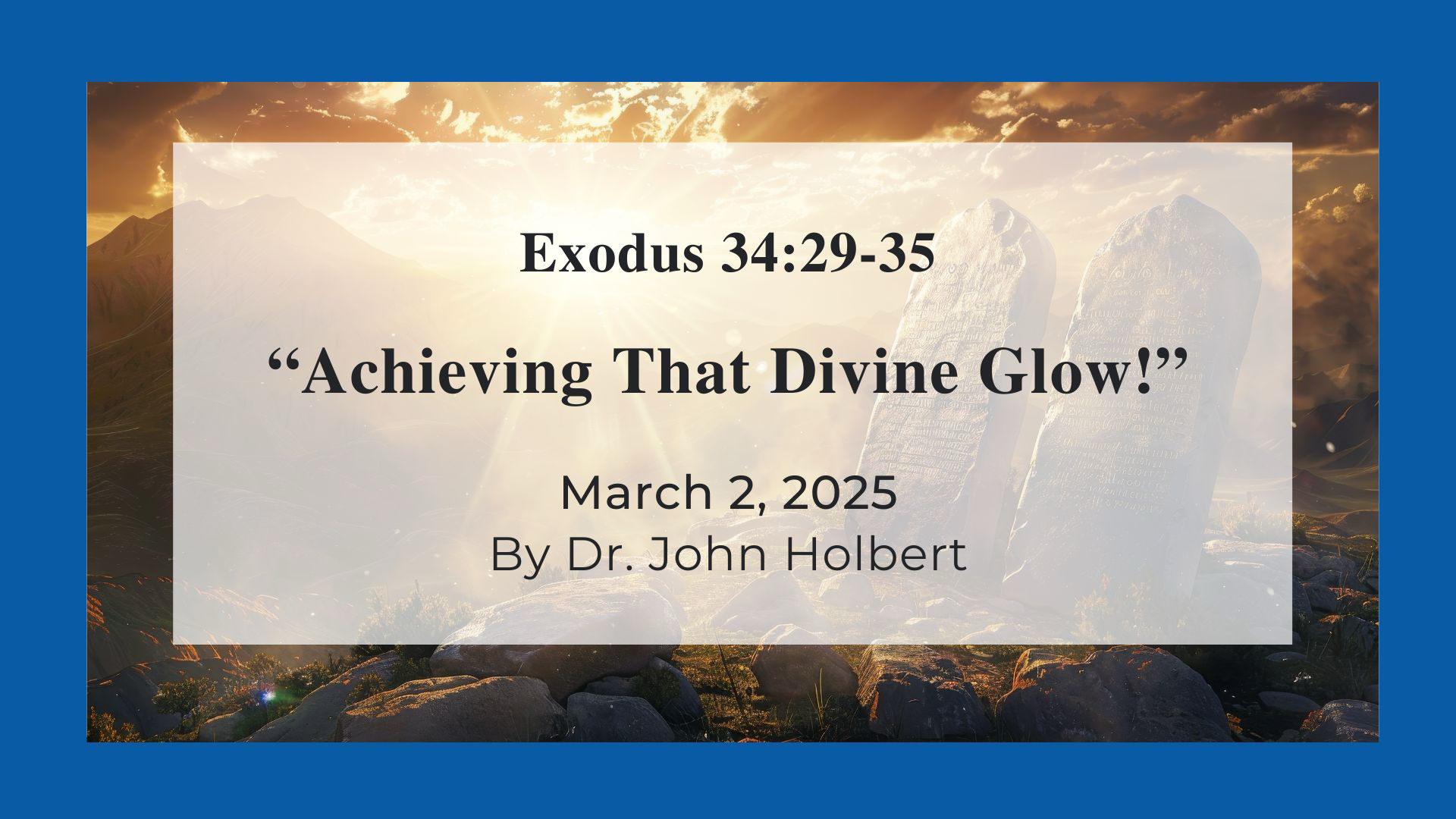Achieving That Divine Glow! Reflections on Exodus 34:29-35, Transfiguration Sunday, Year C
by John C. Holbert on Friday, January 31, 2025

Transfiguration Sunday has always struck me as one of the more peculiar days of the Christian year. On this Sunday, we are asked to celebrate a very odd and mysterious event in the story of Jesus, that time when he goes up a mountain “with Peter, James, and John,” according to Luke 9:28, and while praying there, “the appearance of his face was changed, and his clothes became dazzlingly white.” Something definitely spooky is afoot, and I will offer more details when I comment on the New Testament passage in another essay. Suffice it to say for now that this strange story is deeply reminiscent of another equally strange story from the book of Exodus, one in which another prophet’s face is changed in such a way as to cause great fear among those who witness the change, just as the three disciples experience “terror” upon seeing Jesus, along with Moses and Elijah, enter a cloud, obviously produced by God.
Moses in Ex. 34 has been on the mountain now for forty days, communing with YHWH. This scene is the culmination of a number of occasions where Moses goes up and down the sacred mountain, speaking with God and relaying what God has said to the people at the base of the mountain. This clambering up and down has for a time been short-circuited by the construction of the molten calf, a deed that has infuriated YHWH so much that Moses is convinced that the end of Israel is imminent, so takes it upon himself to talk YHWH out of the divine intention to eliminate these “stiff-necked” Israelites once and for all (Ex.32:7-14, one of the Bible’s most astounding tales). Then Moses demands to know the very essence of YHWH, wanting to see God’s “glory,” but is only allowed to see God’s “good” and then God’s “back,” perhaps God’s “train” or “wake.”
Finally, Moses finds himself again on the mountain with YHWH. YHWH tells him to “Write these words, for because of these words I have sealed a covenant with you and with Israel” (Ex.34:27). So, Moses now himself writes the “Ten Words” (the first time in the tale that this formulation of the Ten Commandments is used) on the fresh tablets carved by YHWH to replace the ones Moses had smashed in raw anger at the base of the mountain when he saw the “calf and the dancing” (Ex.32:19). During his long stay on the mountain this time, he ate no food nor drank any water, suggesting his full devotion to the God who has called him for this special task.
“When Moses came down from mount Sinai, the two tablets of the covenant in his hands, Moses did not know that the skin of his face glowed when he spoke to God” (Ex.34:29). This has become the accepted translation of the Hebrew qeren, though this meaning of the word appears only here in Exodus. The word ordinarily means “horn,” so that the Greek translation of Aquila along with the Latin Vulgate understood it to mean “sprouted horns.” This is why that wonderful statue of Moses by Michelangelo, grandly seated in Rome in the church of San Pietro in Vincoli, has two quite prominent horns sprouting from Moses’ head. Reading the Hebrew literally, it seems patently absurd that horns would grow from “the skin of the face;” they are quite obviously in Michelangelo’s mighty work sprouting from the prophet’s head. Others have suggested that Moses’s skin, in the presence of YHWH, developed a sort of hornlike toughness, a radiation burn from the power of YHWH’s effulgence.
Surely, a divine radiance has altered Moses’s face, and there are any number of Mesopotamian texts that refer to such a radiance covering the face of a god, or a king, or a priest, after a confrontation with divinity. This would then have been a familiar idea to an ancient Hebrew audience. A translation of “glow” also makes clearer sense of the veil that Moses must don whenever he speaks to the people henceforth. He removes the veil when he returns to God, but puts it on again to save the people from overexposure to the divine power, radiating now from Moses’s face. It might also be said that this veil is reminiscent of the covering and curtains of the Tabernacle, that site of holiness that needs to be separated, partitioned off, yet remains accessible to the people.
This odd story reinforces the unique character of Moses, the great lawgiver of Israel, who alone, we are told, speaks to YHWH “face to face,” as “one speaks to a friend.” The figure of Moses, who lad Israel out of Egypt, brought them the Torah from the sacred mountain, and saved them from the rage of YHWH due to their enormous sin of building the molten calf, becomes here a leader unlike any other. Little wonder that when he comes to die on Mount Nebo (Deut.34), no one to this day knows the place where he is buried. In the lore of Israel, there simply is no one like him. In that sense, when Jesus goes up a mountain, and is changed before the eyes of three of his disciples along with Moses and Elijah, he too is seen as unique, so unique that even the previously unique Moses becomes witness to Jesus’ alteration, making him the unique agent of God, thereby dislodging Moses from his perch as supreme and final lawgiver of the people.
The goal of Transfiguration Sunday is to recognize and celebrate the uniqueness of Jesus, and to begin to discover just how extraordinary he is as the center and perfector of our faith and trust.
